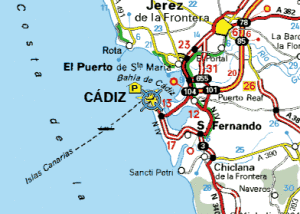Princess Dido
Cádiz
Cádiz is the modern name for ancient Gades considered the original kingdom of Gadeirus the twin brother of Atlas. However, the certainty normally associated with this accepted identification is weakened by the fact that quite a number of locations with similar-sounding names are to be found in the Central and Western Mediterranean regions.
A Map of Cadiz circa 1813 is shown on the right.
It has also been suggested that the name Cadiz came from Gadir, which in turn was derived from Kadesh!
 The Spanish historian, Adolfo Valencia wrote a history of Cádiz[0208], in which he suggested that Atlantis might have extended from Cádiz to Malta.
The Spanish historian, Adolfo Valencia wrote a history of Cádiz[0208], in which he suggested that Atlantis might have extended from Cádiz to Malta.
In 1973, Maxine Asher led an expedition to search for Atlantis off the coast of Cadiz, which despite claims of having discovered Plato’s Island, nothing verifiable was found(a). These claims received global press attention, enabling Asher to dine out on it for the rest of her fraudulent life.
It is generally accepted that the Phoenicians from Tyre founded Gadir, later to be known as Gades to the Romans. The Roman historian, Velleius Paterculus (c.19 BC – c.31 AD) wrote that Cadiz was founded 80 years after the Trojan War, circa 1100 BC. In the 9th century BC, the Phoenicians, under Princess Dido, founded a new capital at Carthage in North Africa. At Gades, the Phoenicians/Carthaginians built a temple to Melqart that had two columns that many consider to be the original Pillars of Hercules. In 2007, it was announced that excavations in the old town centre produced shards of Phoenician pottery and walls dated to the 8th century BC, probably making it the oldest inhabited city in Europe.
In early January 2022, “Archaeologists from the University of Seville and the Andalusian Institute of Historical Heritage claim to have discovered the lost Temple of Hercules Gaditanus. Using information they obtained from documentaries and aerial photographs, the researchers found a large rectangular structure submerged in the Bay of Cadiz. (b)
The structure, nearly 1,000 feet long, 500 feet wide, and matches the ancient descriptions of the temple, is only visible in low tide.”
In September 2023, the latest attempt to revive interest in a Spanish Atlantis was unveiled at a press conference in Chipiona, near Cádiz. The theme of the conference was the discovery of long underwater curved walls that some have claimed to match exactly Plato’s description of Atlantis.
Thorwald C. Franke(c) has more on the background to this effort to put the spotlight on the possibility of Atlantis being situated in this region of Spain which lies at the southern end of the Doñana Marshes that had received extensive investigation over the past couple of decades. The press conference was also used to announce the showing of a new documentary series by Michael Donnellan on October 8th in Cádiz.
Also See: Egadi Islands
(a) 1973 Atlantis Expedition (fourth-millennium.net)
(b) Spanish Archaeologists Claim to Have Discovered The Temple of Hercules (sputniknews.com)

